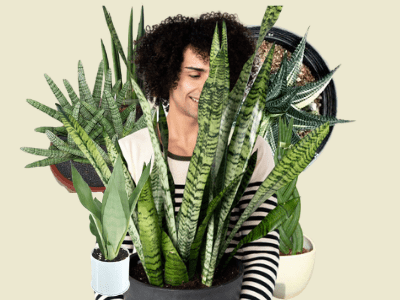
Have You Ever Been Curious About The Unique Sansevieria?
Snake plants, also known as sansevieria, have grown in popularity in recent seasons.
Because of its ease of care, this plant is really popular in every household and worth having.
Sansevieria come in several varieties. The Sansevieria golden wendy…
…and Sansevieria twisted sister are two of them, and perhaps you have it as well.
But, don’t worry, there are many unique sansevieria varieties beside the two previous ones!
So, prepare your space to place the unique Sansevieria in order for the plant to be happy!
On the other hand, if you already have a snake plant, you should know how to care for your snake plant properly.
Before we let you know what are the most varieties of sansevieria…
Let us hear Camila’s story…
Last week, I was thinking about what if I started to have a plant. But I have no gardening experience…
…and I don’t like dirty things.
After I did research about what’s the easiest houseplant, and the top result was Snake Plant!
I like to be different, then I asked on google is snake plants have another variety? It shocked me…
…the result was, it has many varieties! I like the unique types, so not many people won’t…
…have this kind of snake plant. Though it’s more expensive, I would like to have one.
I saw Sansevieria Aubrytiana Jade and I had to buy it immediately!
It took less 10 days to wait the plant, and finally, all arrived healthy…
…in great condition and perfect shape.
This unique sansevieria more beautiful with amazing coloration than I expected from the pictures!
I’m amazed and overjoyed my first plant is beautiful! I wonder to have another rare…
…varieties of snake plant again. Beside that, I admit the snake plants are helping
Snake plants, also know as mother-in-law’s tongue or sansevieria, have become increasingly popular, and rightly so. With their striking lines and hardiness, they’re the houseplants even black thumbs can show off. “
Shifrah Combiths, author from apartmenttherapy.com
If you feel bored with an ordinary or commonly known snake plant, now you’re on the right page!
Here are some unique Sansevierias that you might want to have.
Check this out…
Birds Nest Sansevieria Trifasciata (Hahnii)
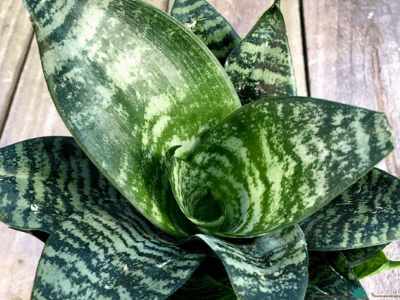
Another word for the first unique sansevieria is:
- Bird’s Nest Sansevieria
- Hahn’s Sansevieria
- Green Sansevieria
Birds’ nests are dwarf cultivars, which makes them suitable for use on a desk or corner table.
Most succulents are easy to grow with just a simple succulent soil mix,
…but for this one unique sansevieria is can grow up to 7″ in size and grow slowly.
Hawaii can also tolerate bright light…
…which will bring out the green color in the leaves.
Since birds nest sansevieria is a small plant, you can put them anywhere! It will make a lovely decor.
Let me show you the next unique sansevieria…
Sansevieria Kirkii
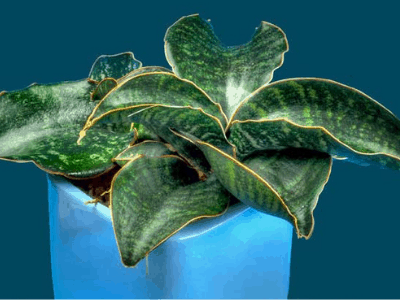
This variety is also known as star sansevieria has succulent leaves that are smooth…
…dark green leaves and wavy edges. It could grow 10″ and is slow-growing.
Kirkii is the one of the hard to find list. If you find another indoor houseplant, kirkii would be…
…a lovely choice, because the size is small, you can put in anywhere spots!
Try to do outdoor experience with kirkii, but you should be on the right climate, and care for the kirikii snake plant well.
But wait, there’s more!
Sansevieria Parva
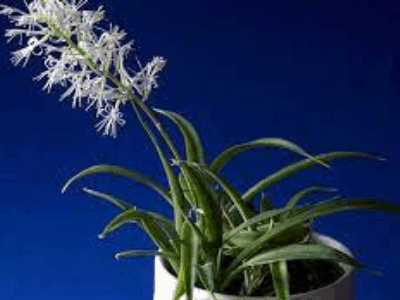
If you admire sansevierias, this variety is one of the unique sansevieria…
…that you’ll want to add to your indoor houseplant collection or outdoor garden.
Another name of sansevieria Parva is Kenya Hyacinth. It could grow 12-20″…
…and has thick 8-16″ long leaves. It’s a superb hanging basket houseplant since it sends…
…out long pendant runners called stolons that end in small plants growing.
At night, the little pale pink to white flowers bloom in spikes and have a delicate hyacinth aroma.
The bright light brings out the colors in the leaves.
Keep reading…
Sansevieria Elleinsis Chahin
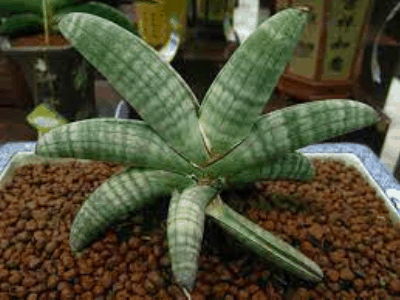
This unique sansevieria is long and cylindrical growing up to 5″ long and 1″ thick. It has bluish-green leaves with…
…white horizontal stripes on them. A deep channel is present in immature plants, which span the entire length…
…of each leaf and have reddish-brown borders with a papery brown cuticle.
Almost there…
Sansevieria Masoniana F. Variegata
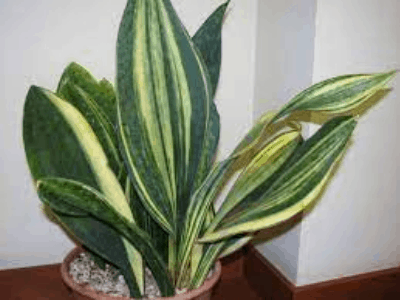
This variety is a semi-succulent variation with a yellow vertical line and a dark green tint.
The leaves can reach a height of 5ft and a width of 10″ and it blossoms…
…appear as a stalk of white flower clusters put on the plant’s center when it blooms.
If grown in intense light, this plant will occasionally produce a stalk of white flower clusters…
…that emerge from the middle of the plant. Though this plant tolerates low light…
….bright light brings out the colors in the leaves.
Keep reading…
Sansevieria Cylindrica (African Spear)
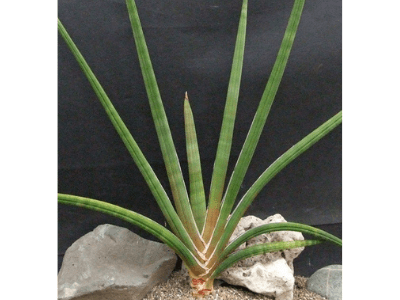
Another this unique sansevieria is grown in a fan shape. The leaves are cylindrical in shape…
…but thin at the tips to a point. It has dark green leaves and could grow to 7ft and around 1″ thick.
African spear plant is as container plants, and once the roots begin to grow out…
…of the container, you won’t have to repot it for at least a few years,
…so the best place to plant is in a container.
The other names of African Spear is:
- Spear Sansevieria
- Spear Orchid Skyline
- Spear Sansevieria
Want to see Camila’s plant? You’re here…
Sansevieria Aubrytiana Jade (Whale Fin)
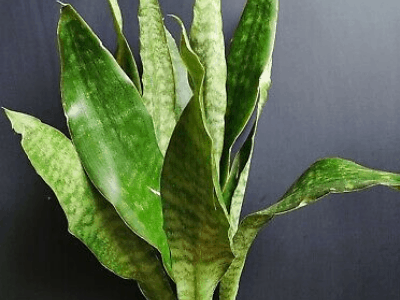
Here we are, I’m pretty sure that you asking yourself “how amazing this variety is?”…
…after you read Camila’s story. Now, you can see, is Camila right?
It has dark green leaves with faded look and light green spots. It’s up to 5ft and 10″ wide.
You should prepare some spaces for this unique sansevieria because it kind of large houseplant.
Of course, also low light tolerance. Like the other varieties before, Aubrytiana has some other names:
- Acyntha Bracteata
- Sansevieria Bracteata
Trust me, you haven’t seen this before…
Sansevieria Cleopatra
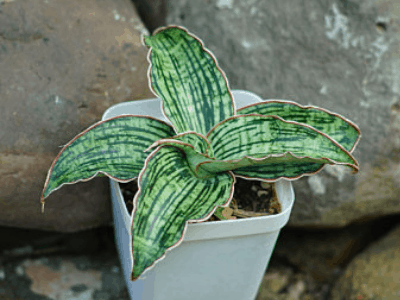
Why do I dare to say you saw this? Because this unique sansevieria is the…
…newest sansevieria hybrid. The leaves have unique patterns, which it still…
…hard to find in the market. It grows as a rosette with leaves that can reach 11″.
It perfectly fits every spot you want because this plant belongs to the medium-size category.
I think this variety has no other names, commonly known as “Sansevieria Cleopatra”.
Sansevieria Essentials
There are several items to have if you want to keep your sansevieria shiny and healthy:
- Pot with Drainage
- Succulent Soil Mix
- Neem Oil
- Natural Fertilizer
- Pruner Scissor
Sansevieria is a type of succulent, that’s why a pot with drainage is needed…
….to keep the soil from mold. Succulent soil mix is essential for snake plants,
…especially if the humidity is high.
Something else that’s also essential to have is neem oil.
It has a lot of benefits to these unique sansevierias,
The oil prevents the snake plants from getting attacked by pests,
Moreover, it makes the leaves shine!
Best Premium Items To Grow Sansevieria Healthily
- Blended for a wide variety of container plants
- Feeds up to 6 months
- Designed to be less prone to gnats (Contains no compost or bark, which are known to shelter fungus gnats)
- Contains coconut coir, which holds and releases water and helps soil easily re-wet
- For use in containers
- SELF-AERATING, HIGH DRAINAGE, MINIMIZE ROOT ROT: No need to keep poking holes in your soil. Integrated into the body of the planter are additional large open slats on the bottom that are designed to maintain air circulation through the soil, minimizing the risk of root rot commonly found in more enclosed self-watering planters.
- MINDS YOUR FLOOR AND CARPET: The bottom saucer is designed with risers that lift it away from your floor and to prevent circular water stains typical of other flat-bottomed planters.
- INSECT KILLER: Controls Aphids, Whiteflies, Spider Mites, Fruit Flies, Mealybugs, Scales and other listed pests
- DISEASE CONTROL: Fungicide controls Blackspot, Rust, Powdery Mildew, and more
- USE ON: For use on Roses, Flowers, Fruits and Vegetables and Shrubs
- ORGANIC GARDENING: Can be used up to the day of harv
Let’s recap…
Sum Up
In short, one of the reasons to have sansevieria for newbie gardeners…
…are that they can grow well in every condition. You don’t always need to water or dry in the sun.
Also, you can put it in low lightroom or indoors, and your snake plants are still happy.
Those are some unique sansevieria that are really incredible. Look at their leaves it’s so authentic and looks elegant.
Every variety is different care or handle, but most are the same care. The differences are only on the leaves…
…and soil, and the climate.
Conclusion
That unique sansevieria is not easy to find, even in the online market.
If you want to find or buy one of those…
…we suggest you join some Sansevieria-specific or general houseplant-loving communities.
And get ready with your money too the more unique sansevieria the higher the price.
If you get one of those unique varieties, you also can…
…be succulents, especially sansevieria gardeners, and conserve the unique varieties.
Think twice before you buy.
Frequently Asked Questions
How can I identify which Sansevieria species to use for my needs?
The Sansevieria plant genus includes many different species of plants which can be used for succulent plant cultivation.
A good way to identify which Sansevieria species to use for your needs is by consulting with a plant breeder or plant dealer who can help you choose the best cultivar for your specific needs.
Where can I get rare Sansevieria plants?
The source of information for the facts and figures in this question is the University of Florida’s Rare Plant Database.
Are there any specific conditions that Sansevieria should be used for?
Sansevieria is a plant that can be used for a variety of purposes, including watering plants, cleaning and purifying air, and as an ornamental plant.



